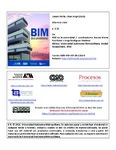Mostrar el registro sencillo del ítem
BIM en la UAM
| Autor: | Carpio Utrilla, César Jorge |
| Fecha de publicación: | 2018 |
| URI: | http://hdl.handle.net/11191/6686 |
| Resumen: | Durante el desarrollo del proyecto ejecutivo en taller, se tiene que tomar en cuenta la posibilidad de que éste presente defectos importantes en el momento de llevarlo a su realización, investigadores han insistido que porcentajes importantes de ellos tienen sus orígenes en decisiones y acciones tomadas durante las etapas de diseño. Los procedimientos actuales no logran los estándares en costo, tiempo, calidad, seguridad y sustentabilidad que se requieren debido al divorcio que existe entre el diseño y la construcción. En este trabajo se examina la problemática existente y se propone una metodología BIM (Building Information Modeling), que utiliza diferentes programas de software, no siempre compatibles entre sí, o no relacionadas a las actividades de Diseño, Ingeniería Civil o constructivas, y que permiten al arquitecto administrar las diferentes etapas del trabajo arquitectónico. A su vez, ésta es una Metodología ya utilizada en otros países que reduce los Defectos de todo tipo a su mínima expresión, la metodología presenta grandes ventajas en cuanto a la enseñanza en arquitectura, porque permite que interactúen distintos especialistas en la realización del proyecto, logrando la calidad y demás estándares solicitados. |
| Resumen: | During the Project development inside the workshop, you must take care of the defects probability when implementing it, researchers insists that a big rate of defects originate from actions and decisions taken at the design stages. The actual procedures fails the standards of cost, time, quality, safeness and sustainability caused by the differences between design and construction. This report reviews the existing problematic and proposes the BIM (Building Information Modeling), It uses different software that not always are compatible between them or there are not related with the design activities, Civil engineering or constructive and they allows the architect manage the different architectonic work stages at the same time. This methodology, which is already used in other countries and reduces the defects to its minimal expression, also the methodology presents huge advantages inside the architecture education, because it allows the interaction between different specialists when developing a project, reaching the quality and all the standards requested. Five uses related to the construction phase of BIM were selected. Also the responsibilities of the participants and the technology to use were defined, based on the availability and dominion of the software. Among the most important results is that by defining a BIM model based on a specific application, the utility of the models can be optimized in the implementation phase and reduce unnecessary modeling efforts. |
| Formato: | |
| Idioma: | spa |
| Editor: | Universidad Autónoma Metropolitana (México). Unidad Azcapotzalco. |
| Fuente: | BIM en la universidad, 2018 (ISBN: 978-607-28-1316-8) |
| Palabras clave: | Defectos; Decisiones y acciones; Estándares constructivos; Interacción; Acciones; Modelado de edificios con programas de software diversos; Ventajas en la enseñanza de la arquitectura; Defects; Actions and decisions; Construction Standard; Interaction Specialists; Advantages inside the architecture education; Building modeling with different kind of software. |
| Materias: | HUMANIDADES Y CIENCIAS DE LA CONDUCTA::CIENCIAS DE LAS ARTES Y LAS LETRAS::ARQUITECTURA::DISEÑO ARQUITECTÓNICO |
| Título: | BIM en la UAM |
| Tipo de publicación: | Capítulo de libro |



